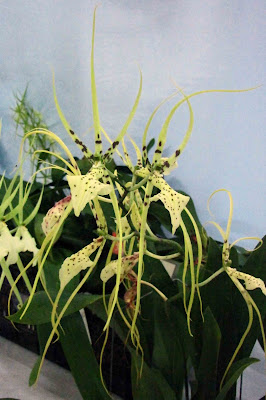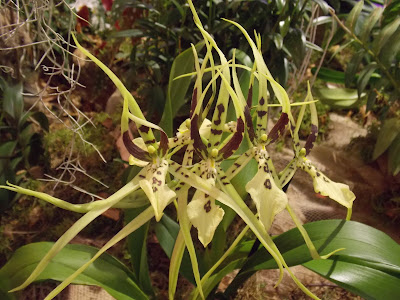Brassia wageneri - Wagner's Brassia is found growing on trees in cool, wet montane forests of Brazil North, Colombia, Guyana, Peru, Venezuela...
Brassia wageneri, also called as Wagner's Brassia, Brassia bicolor, Brassia cryptophthalma, Oncidium wageneri, is a species of the genus Brassia. This species was described by Heinrich Gustav Reichenbach in 1854.
IDENTIFY BRASSIA WAGENERI - WAGNER'S BRASSIA
Brassia wageneri is native to Southern Tropical America. It is found growing on trees in cool, wet montane forests of Brazil North, Colombia, Guyana, Peru, Venezuela at elevations of 480 to 1800 meters above sea level.
It is a bifoliate, small to medium sized, warm to cool growing, epiphytic species with elongate, tapered, strongly compressed, smooth, light green pseudobulbs subtended by a basal leafless sheath and an upper leaf bearing sheath. The leaves are apical, lanceolate, acuminate conduplicate towards the base.
Wagner's Brassia blooms in the spring, summer and fall on a basal, through a leaf sheath, to 20 cm long, suberect to arching, terete, green, 8 to 15 flowered, racemose inflorescence that is shorter than the leaves and arises on a mature pseudobulb. The flowers are 12 cm in diameter, yellow with narrow sepals and petals spotted dark brown and a large, pointed, prominent, reflexed lip.
BRASSIA WAGENERI - WAGNER'S BRASSIA CARE AND CULTURE
Cultural information should only be used as a guide, and should be to be adapted to suit you. Your physical location; where you grow your plants, how much time you have to devote to their care, and many other factors, will need to be taken into account. Only then can you decide on the cultural methods that best suit you and your plants.
Light:
Brassia wageneri needs a light level of 20000-30000 lux. The amount of light needed can be determined from where these orchid plants reside. The species can be grown on any windowsill in the home except for a north facing one. If you decide to grow your orchid in a south facing window you will want to make sure that you filter the light with a sheer curtain so that the plant doesn’t get direct sunlight because this could cause sunburn.
A good indicator of whether your orchid is getting the right amount of light can be determined by the color of the leaves. Mid green color leaves are what you are ideal. If the orchid is not getting enough light the leaves will begin to turn dark green light will need to be increased. If they are getting too much light they will turn yellow and the amount of light will need to be decreased. If you change the amount of light your orchid receives and you see no change in leaf color then change your fertilizing schedule to adjust the color.
Temperature:
Wagner's Brassia prefers temperatures of 18 - 24 °C, and night temperatures should be between 13 - 18 °C. At high temperatures, the plants will grow faster, so it is necessary to irrigate more often and should not let the plant dry because it will be difficult to recover and difficult to flower. Plants will flower more easily when the temperature is difference between day and night.
Humidity:
Brassia wageneri needs the humidity level of 50 - 70% for daytime, and night from 80 - 95%. Too dry air has a negative effect on the development of the plant: its growth is inhibited, and the leaves begin to turn yellow and dry out. The higher temperature, the higher the humidity should be, and the higher the humidity, the more often and longer it is necessary to ventilate the room where the plants are contained, otherwise the probability of rotting and various kinds of fungal diseases.
When you have high humidity levels, it is equally important to maintain proper air movement to prevent orchid disease from developing. If you notice that your orchid is beginning to develop brown spots on its leaves, this is an indication that you need to increase air circulation. You can increase air movement for your orchid by placing an oscillating fan nearby.
Substrate, growing media and repotting:
Wagner's Brassia is usually grow in pot, hanging baskets, but you can also mount the plant to a piece of bark or wood, like it would grow in the wild. A course-grade potting medium consisting of bark, coconut chips, charcoal, or perlite is ideal and will provide proper drainage.
Repotting will be necessary occasionally. Repotting will not only be needed if the potting medium begins to decompose but also in the case that the plant needs to be divided because of new pseudobulbs added each year. If the potting medium begins to smell bad it is decomposing and will need to be repotted right away. You will also need to repot the plant if any mold or fungus appears on the potting medium. If planted in plastic pots, the plant should be repot every two years, because salt will last much in the pot or burn and cause root dead.
Watering:
Water in the summer 2-3 times a week because it is a period of strong growth, but winter can be from 7 to 10 days and then irrigation. In the growth period, do not let the plant dry because it will be difficult to recover when the rhizome shrink. Occasionally add fungicides and kill bacteria to prevent root rot in winter, especially cold areas.
Watering is directly dependent on the temperature of the content, the higher it is, the more often it needs to be watered. When watering, excess water should flow freely from the pot, since stagnation of water both inside the pot and in its pan can very quickly lead to rotting of the roots and the lower part of the plant.
Fertilizer:
Use 1/4 teaspoon 20-20-20 or 20-10-20, or 20-30-20 with 4 liters of water for irrigation each week, if the leaves are burnt to the top, it mean you have fertilizer too much, so take a while, only water, about 2 weeks and then fertilize again.
It is important to flush out any excess fertilizer (once a month) so that the excess build-up of salt does not do damage to the plant’s roots or leaves. After your orchid has finished blooming, you can hold off on fertilizing your orchid until you begin to see new growth.
Rest period:
Brassia wageneri are sometimes reluctant to bloom. If your plant is well-fed, has tons of pseudobulbs and bright green leaves yet refuses to bloom, you might be coddling it. Put it outside in brighter during the spring/summer so that the leaves gradually turn a very light green. Feed it well, but let it dry out between waterings, and don't fuss over it too much. Then stand back and wait for the flowers.
After the bloom, the plants need a rest for about 6-8 weeks. Provide lower light levels, slightly cooler temperatures (no cooler than 16°C), cut back on watering, and stop fertilizing. Don't skip this much-needed rest, it helps trigger future flowers.
BUY BRASSIA WAGENERI - WAGNER'S BRASSIA AND RELATED PRODUCTS
BUY ANOTHERS SPECIES AND VARIETIES OF BRASSIA ORCHID GENUS HERE!















COMMENTS